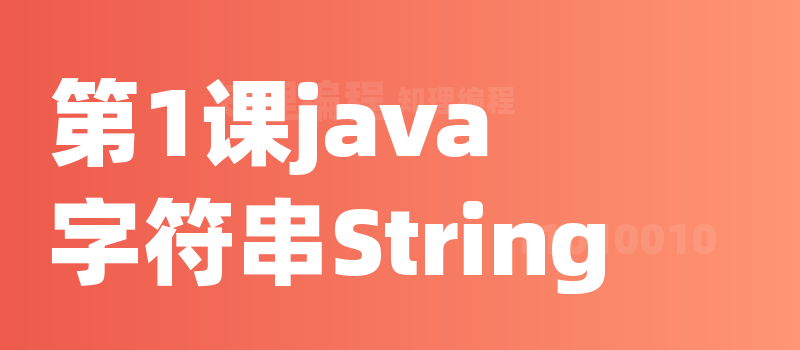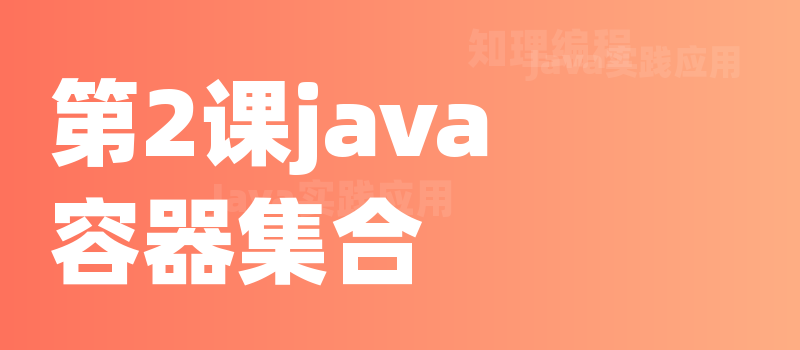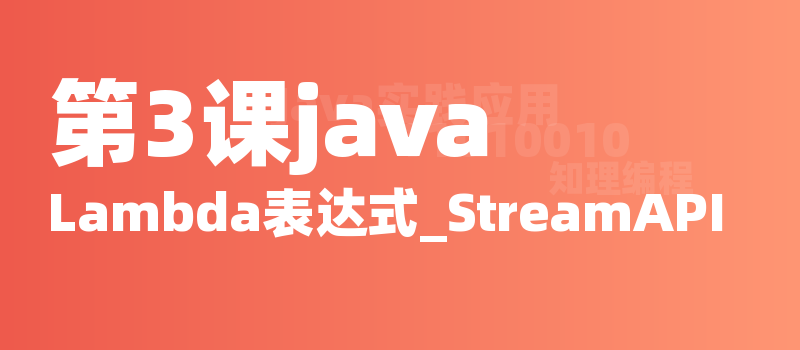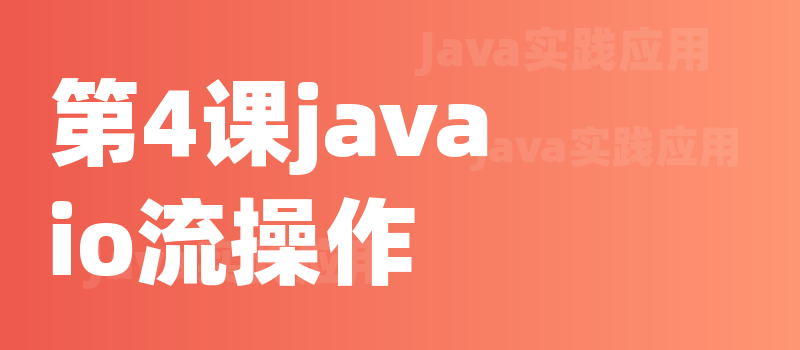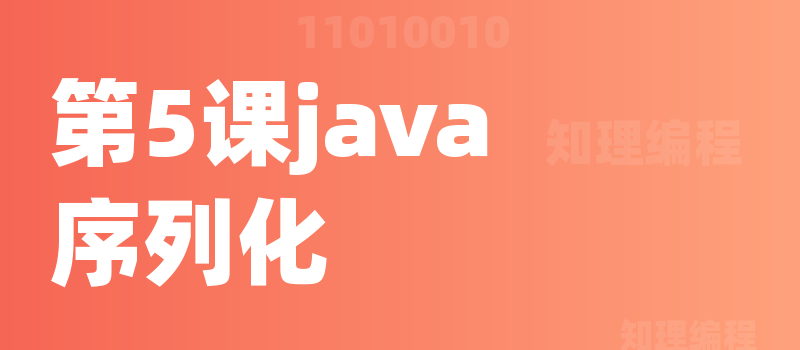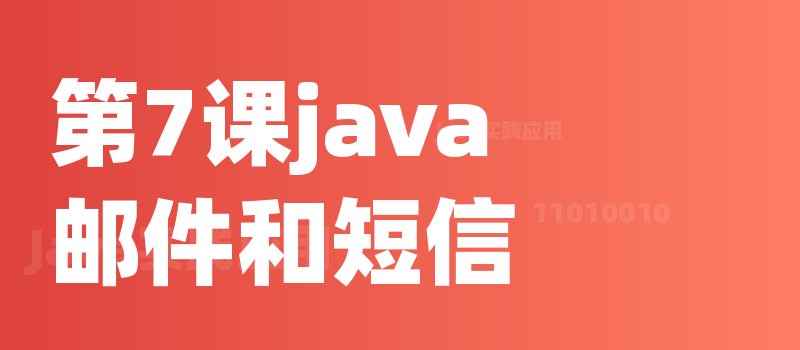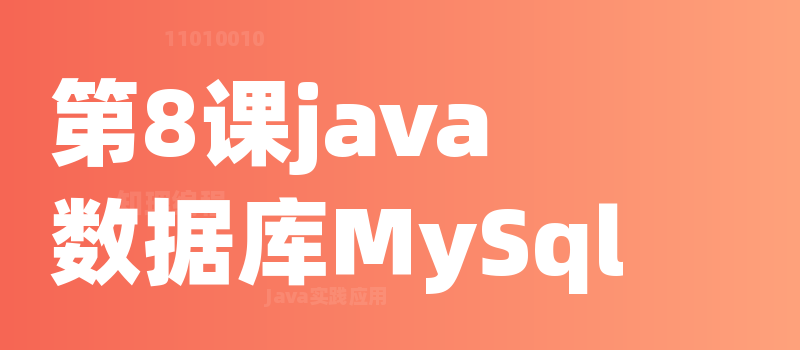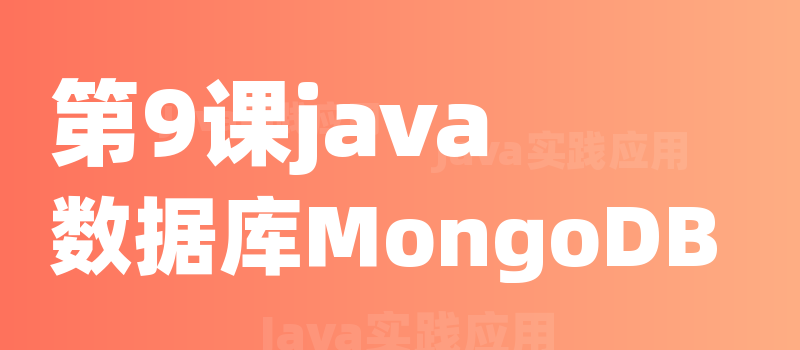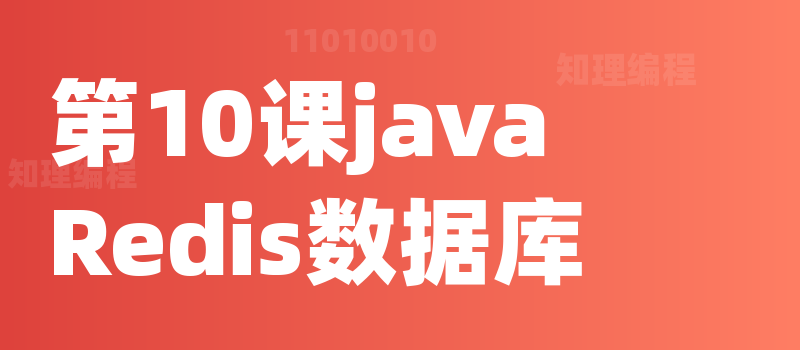第4课java_io流操作
热度🔥:104 免费课程
授课语音
Java的IO操作
1. 介绍
Java的IO(输入/输出流)是处理数据读写的核心机制。Java中的IO操作主要包括输入流和输出流。根据数据类型的不同,IO可以分为字节流和字符流。
字节流
字节流用于处理所有类型的数据。主要的字节流类有:
java.io.InputStream:读取字节数据的抽象类。java.io.FileInputStream:用于从文件中读取字节数据。java.io.ByteArrayInputStream:用于从字节数组中读取数据。java.io.FilterInputStream:过滤输入流的父类。java.io.BufferedInputStream:为输入流添加缓冲功能,减少IO调用次数,提高性能。java.io.DataInputStream:读取原始数据类型。java.io.PushbackInputStream:提供一个单字节的回推缓冲区。java.io.ObjectInputStream:从流中读取对象数据,用于反序列化。
java.io.OutputStream:写入字节数据的抽象类。java.io.FileOutputStream:用于向文件中写入字节数据。java.io.ByteArrayOutputStream:用于写入字节数组。java.io.FilterOutputStream:过滤输出流的父类。java.io.BufferedOutputStream:为输出流添加缓冲功能。java.io.DataOutputStream:写入原始数据类型。java.io.PrintStream:提供各种打印数据的功能。java.io.ObjectOutputStream:向流中写入对象数据,用于序列化。
字符流
字符流专门用于处理文本数据。主要的字符流类有:
java.io.Reader:用于读取字符数据的抽象类。java.io.FileReader:用于从文件中读取字符。java.io.BufferedReader:为输入流添加缓冲功能。java.io.InputStreamReader:将字节流转换为字符流。java.io.StringReader:从字符串中读取字符。java.io.FilterReader:过滤输入流的父类。java.io.PushbackReader:提供单一字符的回推缓冲区。
java.io.Writer:用于写入字符数据的抽象类。java.io.FileWriter:向文件中写入字符。java.io.BufferedWriter:为输出流添加缓冲功能。java.io.OutputStreamWriter:将字符流转换为字节流。java.io.StringWriter:写入字符缓冲区。java.io.FilterWriter:过滤输出流的父类。
文件处理
java.io.File:用于处理文件和目录路径。java.io.RandomAccessFile:支持文件的随机访问。
IO性能最佳实践
- 使用缓冲流减少IO读取次数,提升性能。
- 优化传输数据格式,例如使用二进制或压缩格式。
- 监控IO性能瓶颈,定期优化IO操作的代码,避免频繁创建和销毁IO对象,并及时回收资源。
2. 代码案例
import java.io.*;
// 用于对象流示例的类
class Person implements Serializable {
private static final long serialVersionUID = 1L; // 版本控制
private String name; // 姓名
private int age; // 年龄
public Person(String name, int age) {
this.name = name; // 构造函数
this.age = age;
}
@Override
public String toString() {
return "Person{name='" + name + "', age=" + age + '}'; // 重写toString方法
}
}
public class IoDemo {
public static void main(String[] args) {
String filePath = "example.txt"; // 文件路径
String content = "Hello, Java IO!"; // 写入内容
// 文件写入和读取
writeFile(filePath, content);
String fileContent = readFile(filePath);
System.out.println("文件内容: " + fileContent);
// 字节流读写示例
byteStreamExample(filePath);
// 字符流读写示例
charStreamExample(filePath);
// ByteArray流示例
byteArrayStreamExample(content);
// Data流示例
dataStreamExample(filePath);
// Object流示例
objectStreamExample(filePath);
// Print流示例
printStreamExample(filePath);
// File和RandomAccessFile示例
fileAndRandomAccessFileExample(filePath);
// StringReader和StringWriter示例
stringReaderWriterExample(content);
}
// 写入文件
public static void writeFile(String filePath, String content) {
try (FileOutputStream fos = new FileOutputStream(filePath)) { // 创建文件输出流
fos.write(content.getBytes()); // 将字符串转换为字节数组并写入
} catch (IOException e) {
e.printStackTrace(); // 打印异常信息
}
}
// 读取文件
public static String readFile(String filePath) {
StringBuilder content = new StringBuilder(); // 用于存储读取的内容
try (FileInputStream fis = new FileInputStream(filePath)) { // 创建文件输入流
int byteRead;
while ((byteRead = fis.read()) != -1) { // 循环读取字节
content.append((char) byteRead); // 将字节转换为字符并追加
}
} catch (IOException e) {
e.printStackTrace(); // 打印异常信息
}
return content.toString(); // 返回读取的内容
}
// 字节流读写示例
public static void byteStreamExample(String filePath) {
try (FileInputStream fis = new FileInputStream(filePath);
FileOutputStream fos = new FileOutputStream("copy_" + filePath)) { // 创建输入输出流
byte[] buffer = new byte[1024]; // 定义缓冲区
int bytesRead;
while ((bytesRead = fis.read(buffer)) != -1) { // 读取字节
fos.write(buffer, 0, bytesRead); // 将读取的字节写入目标文件
}
System.out.println("字节流复制成功!");
} catch (IOException e) {
e.printStackTrace(); // 打印异常信息
}
}
// 字符流读写示例
public static void charStreamExample(String filePath) {
try (FileReader fr = new FileReader(filePath);
FileWriter fw = new FileWriter("char_copy_" + filePath)) { // 创建字符输入输出流
char[] buffer = new char[1024]; // 定义字符缓冲区
int charsRead;
while ((charsRead = fr.read(buffer)) != -1) { // 读取字符
fw.write(buffer, 0, charsRead); // 将读取的字符写入目标文件
}
System.out.println("字符流复制成功!");
} catch (IOException e) {
e.printStackTrace(); // 打印异常信息
}
}
// ByteArray流示例
public static void byteArrayStreamExample(String content) {
try (ByteArrayOutputStream baos = new ByteArrayOutputStream()) { // 创建字节数组输出流
baos.write(content.getBytes()); // 将内容写入流
byte[] byteArray = baos.toByteArray(); // 转换为字节数组
System.out.println("ByteArray 流内容: " + new String(byteArray)); // 输出内容
} catch (IOException e) {
e.printStackTrace(); // 打印异常信息
}
}
// Data流示例
public static void dataStreamExample(String filePath) {
try (DataOutputStream dos = new DataOutputStream(new FileOutputStream(filePath))) { // 创建数据输出流
dos.writeInt(123); // 写入整数
dos.writeDouble(45.67); // 写入浮点数
dos.writeUTF("Hello DataOutputStream"); // 写入字符串
System.out.println("Data 流写入成功!");
} catch (IOException e) {
e.printStackTrace(); // 打印异常信息
}
try (DataInputStream dis = new DataInputStream(new FileInputStream(filePath))) { // 创建数据输入流
int intValue = dis.readInt(); // 读取整数
double doubleValue = dis.readDouble(); // 读取浮点数
String stringValue = dis.readUTF(); // 读取字符串
System.out.println("Data 流读取成功:");
System.out.println("整数值: " + intValue);
System.out.println("浮点值: " + doubleValue);
System.out.println("字符串值: " + stringValue);
} catch (IOException e) {
e.printStackTrace(); // 打印异常信息
}
}
// Object流示例
public static void objectStreamExample(String filePath) {
try (ObjectOutputStream o
os = new ObjectOutputStream(new FileOutputStream(filePath))) { // 创建对象输出流
Person person = new Person("John", 30); // 创建对象
oos.writeObject(person); // 写入对象
System.out.println("Object 流写入成功!");
} catch (IOException e) {
e.printStackTrace(); // 打印异常信息
}
try (ObjectInputStream ois = new ObjectInputStream(new FileInputStream(filePath))) { // 创建对象输入流
Person person = (Person) ois.readObject(); // 读取对象并强制转换
System.out.println("Object 流读取成功:");
System.out.println(person); // 输出对象信息
} catch (IOException | ClassNotFoundException e) {
e.printStackTrace(); // 打印异常信息
}
}
// Print流示例
public static void printStreamExample(String filePath) {
try (PrintWriter pw = new PrintWriter(new FileWriter(filePath))) { // 创建打印输出流
pw.println("Hello, PrintWriter!"); // 打印字符串
pw.printf("Number: %d, Floating point: %.2f%n", 123, 456.78); // 格式化输出
System.out.println("Print 流写入成功!");
} catch (IOException e) {
e.printStackTrace(); // 打印异常信息
}
try (BufferedReader br = new BufferedReader(new FileReader(filePath))) { // 创建缓冲输入流
String line;
System.out.println("Print 流读取内容:");
while ((line = br.readLine()) != null) { // 逐行读取
System.out.println(line); // 输出读取的行
}
} catch (IOException e) {
e.printStackTrace(); // 打印异常信息
}
}
// File和RandomAccessFile示例
public static void fileAndRandomAccessFileExample(String filePath) {
File file = new File(filePath); // 创建文件对象
System.out.println("文件路径: " + file.getAbsolutePath()); // 输出文件路径
System.out.println("文件是否存在: " + file.exists()); // 检查文件是否存在
System.out.println("文件长度: " + file.length() + " 字节"); // 输出文件长度
try (RandomAccessFile raf = new RandomAccessFile(file, "rw")) { // 创建随机访问文件流
raf.seek(raf.length()); // 移动到文件末尾
raf.writeBytes("Appending some text to the end of the file.\n"); // 追加文本
System.out.println("RandomAccessFile 追加成功!");
raf.seek(0); // 移动到文件开头
System.out.println("RandomAccessFile 读取内容:");
String line;
while ((line = raf.readLine()) != null) { // 逐行读取
System.out.println(line); // 输出读取的行
}
} catch (IOException e) {
e.printStackTrace(); // 打印异常信息
}
}
// StringReader和StringWriter示例
public static void stringReaderWriterExample(String content) {
// 使用StringWriter写入数据
try (StringWriter sw = new StringWriter()) { // 创建字符串写入流
sw.write(content); // 写入内容
String result = sw.toString(); // 获取结果
System.out.println("StringWriter 内容: " + result); // 输出内容
} catch (IOException e) {
e.printStackTrace(); // 打印异常信息
}
// 使用StringReader读取数据
try (StringReader sr = new StringReader(content)) { // 创建字符串读取流
int charRead;
StringBuilder sb = new StringBuilder(); // 用于存储读取的字符
while ((charRead = sr.read()) != -1) { // 逐字符读取
sb.append((char) charRead); // 将字符追加到结果
}
System.out.println("StringReader 读取内容: " + sb.toString()); // 输出内容
} catch (IOException e) {
e.printStackTrace(); // 打印异常信息
}
}
}
这段代码展示了Java IO操作的多种应用场景,包括文件读写、字节流和字符流的操作,以及如何使用数据流、对象流和打印流等。每个示例都有详细的中文注释,帮助理解代码的每一步操作。
